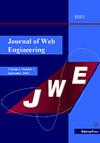在生成的代码中集成手工更改的新方法:无缝mdd
IF 1
4区 计算机科学
Q4 COMPUTER SCIENCE, SOFTWARE ENGINEERING
引用次数: 0
摘要
模型驱动的开发(MDD)通过从更高抽象层次的模型生成源代码,显著地改进了web开发,这提高了生产力,并实现了更短、更便宜的开发周期。然而,并不是web应用程序的所有方面都可以在模型中捕获,因此需要手动更改生成的代码。为了防止由于后续代码生成而导致的手动更改丢失,文献中推荐了各种策略:将手写和生成的代码保存在单独的文件中,利用受保护的区域,或者使用版本控制系统(VCS)合并手写和生成的代码。不幸的是,这些方法会给web应用程序架构带来复杂性,并给开发人员带来额外的负担。本文介绍了SeamlessMDD,这是我们用于无缝集成的新颖开源框架,它允许我们在不需要调整web应用程序架构或建立工作流的情况下维护手写和生成的代码。该框架提供了以下特性:(1)从模型版本比较中派生的增量和迭代转换,确保仅生成或修改受影响的模型元素的代码;(2)使用基于api的代码生成器(ABG)对目标编程语言的语法树进行操作,将生成的和手写的代码集成在一起;(3)对变更传播和冲突解决的特定案例支持,而不是在单线上运行的基于vcs的系统。所提出的特性在一个复杂的工业MDD工具中进行了实践测试。本文是在芬兰坦佩雷举行的第24届网络工程国际会议上发表的一篇论文的扩展版本。本文章由计算机程序翻译,如有差异,请以英文原文为准。
A Novel Approach to Integration of Manual Changes in Generated Code: SeamlessMDD
Model-driven development (MDD) significantly improves web development by generating source code from models at higher abstraction levels, which enhances productivity and enables shorter, less expensive development cycles. However, not all aspects of a web application can be captured in a model, necessitating manual changes to the generated code. To prevent the loss of manual changes due to subsequent code generation, various strategies are recommended in the literature: keeping handwritten and generated code in separate files, utilizing protected regions, or employing a version control system (VCS) to merge handwritten and generated code. Unfortunately, these approaches can introduce complexity into web application architecture and impose an additional burden on developers. This paper presents SeamlessMDD, our novel open-source framework for seamless integration that allows us to maintain handwritten and generated code intertwined without the need to adjust the web application architecture or established workflows. The framework provides the following features: (1) incremental and iterative transformations derived from model versions comparison ensuring that only code for affected model elements is generated or modified; (2) integration of generated and handwritten code using API-based code generators (ABG) that operate on the syntax trees of target programming languages; (3) case-specific support for change propagation and conflict resolution, as opposed to VCS-based systems that operate on a single line. The proposed features were tested in practice within a complex industrial MDD tool. This paper is an extended version of a paper presented at the 24th International Conference on Web Engineering, held in Tampere, Finland.
求助全文
通过发布文献求助,成功后即可免费获取论文全文。
去求助
来源期刊

Journal of Web Engineering
工程技术-计算机:理论方法
CiteScore
1.80
自引率
12.50%
发文量
62
审稿时长
9 months
期刊介绍:
The World Wide Web and its associated technologies have become a major implementation and delivery platform for a large variety of applications, ranging from simple institutional information Web sites to sophisticated supply-chain management systems, financial applications, e-government, distance learning, and entertainment, among others. Such applications, in addition to their intrinsic functionality, also exhibit the more complex behavior of distributed applications.
 求助内容:
求助内容: 应助结果提醒方式:
应助结果提醒方式:


